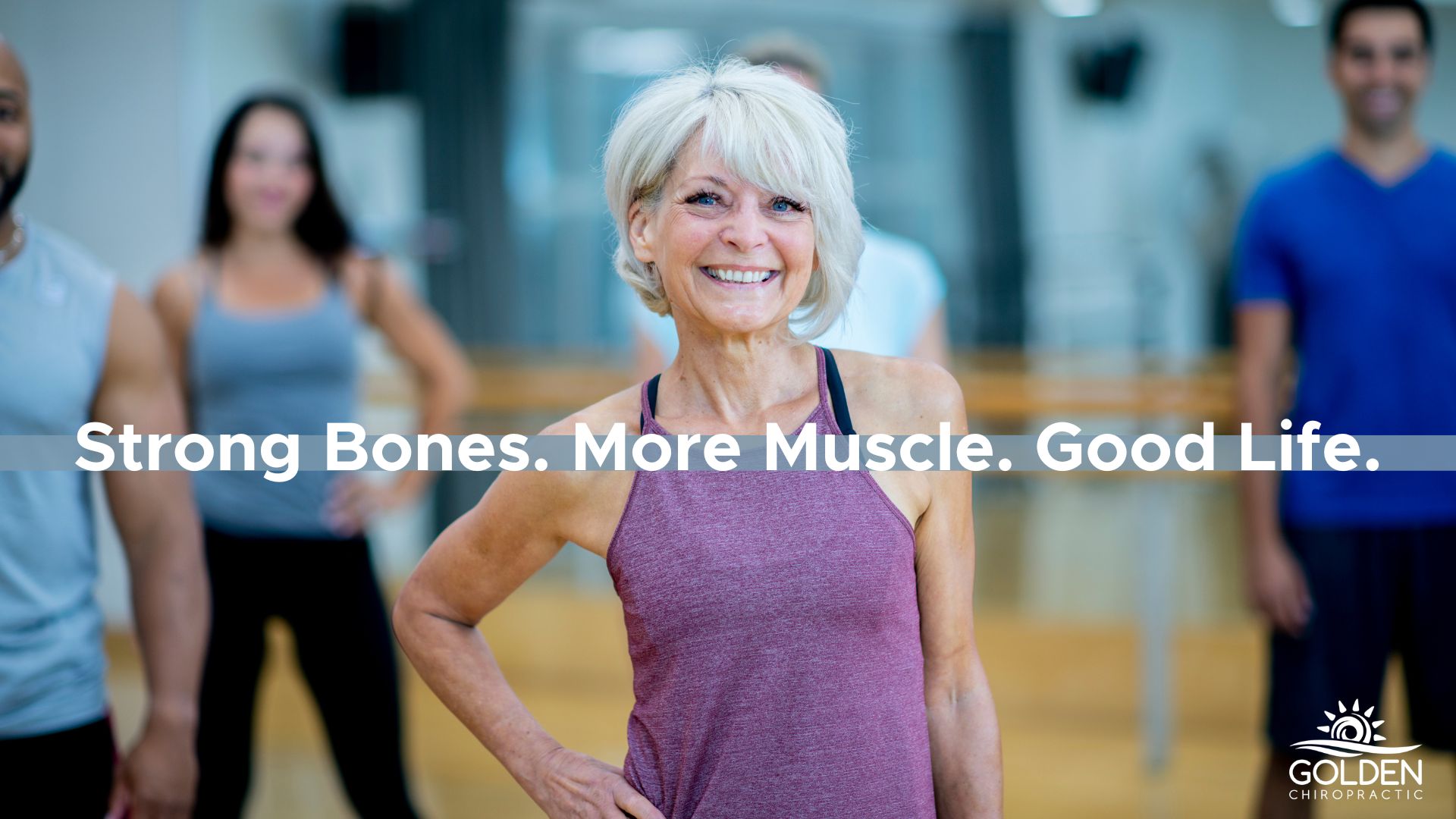
06/23/2022 by Dr. Goldi Jacques-Maynes
Aging Strong: Falls and Broken Bones are Often Optional
Aging, as they say, isn’t for the faint-hearted. And, yes, growing older can have its challenges, but it doesn't have to mean a weak and unstable body.
Aging is often associated with a slower metabolism, loss of balance, loss of strength, reduced mobility and reduced range of motion. These common traits of aging ARE NOT inevitable, though. If you want to age strong, you have to prioritize a very important act of self-care: regular exercise.
If exercise were advertised on TV like pharmaceuticals, most people would “ask their doctor about” this "miracle" drug.
While exercise is not a patented drug, I do prescribe some form of it to almost every patient. Exercise is the best prescription for an excellent quality of life, especially as you move into your elder years. You can even see benefits if you begin exercising later in life.
68 year-old Kate used to fall down a lot.
Kate retired about five years ago, and had a total knee replacement 3 years ago.
Since then she’s been more sedentary, has put on about 20 pounds, and feels weak in her legs and arms.
Kate fell on her right hip while moving too quickly, and her back has hurt ever since. She notes that she’s had a series of falls this year, but this was the worst fall.
First, Kate & I worked on reducing pain and rebuilding core strength.
Chiropractic adjustments helped Kate with her symptoms of low back pain. Gentle core activation exercises (there’s that exercise I love to prescribe) improved her ability to support her spine while moving. Kate began to experience more ease with bending, walking, changing positions, etc.
Kate also prioritized working on her balance.
Kate started to watch Tai Chi and Chi Gong exercise classes on YouTube to work on her balance. Now that she is regaining strength, balance, and stability, she’s thinking about finding a pool or gym to take exercise classes. Go Kate!
So why do we “slow down” as we age?
It’s all about muscle mass.
You progressively lose muscle mass at a rate of about 0.7 percent a year starting in your mid-30’s and 40’s.
For women with ovaries, this muscle mass loss accelerates during the menopause transition. The good news is that it levels back to age-related loss after menopause.
Less muscle = lower metabolism.
Muscle mass is responsible for metabolism because your muscles are a major source of energy consumption. As you age and lose muscle mass, your metabolism slows down.
Muscles move bones thru space.
Muscles give us strength and the ability to move. When you contract a muscle your bones move. Less muscle means less movement.
Muscles help with balance and strengthen bone.
Another consequence of loss of muscle strength is increased risk for falls and fractures. When enough muscle mass is lost, your ability to move is compromised. This is why you may need assistance with getting out of a chair or caring for yourself when you get older. This is called sarcopenia.
Sarcopenia is a loss of muscle mass and function in the elderly. It reduces mobility, diminishes quality of life, and can lead to fall-related injuries.
You can avoid costly hospitalization and extended rehabilitation by exercising to maintain or regain muscle mass.
It’s NEVER too late to “speed back up!”
In one study, adults aged 65-80 were 59% weaker than younger controls in their 20’s. After six months of strength training the older group improved their strength by 21%, moving up from 59% to 38% weaker than the younger adults.
Even 80-90 year olds can exercise to build muscle mass and strength, while also improving balance and mobility, and reducing falls.
The best way to slow the decline of muscle mass, and even reverse the loss, is thru physical activity.
Exercise triggers repair or replacement of muscle cells.
Exercise is also protective. There is a link between exercise and:
- lower rates of heart disease
- lower rates of stroke
- reduced rates of type 2 diabetes
- improved glucose control for people with diabetes
- reduction in many cancers
- lower risk of dementia
Exercises I may prescribe include:
Aerobic Exercise
150 minutes of moderate activity, or 75 minutes of vigorous activity a week is all it takes.
Moderate activity means you can talk while exercising, but not sing. With vigorous exercise, talking is hard. The goal is to build up to 300 minutes of moderate exercise or 150 min of vigorous exercise.
Muscle-Strengthening Exercises
Think lifting weights, machines in a gym, or resistance bands.
The goal is to target all your major muscle groups 2 or more times a week. Eccentric exercises, where the muscle is working while it is extending or lengthening, are particularly important. A good example is the Biceps curl while the weight is being lowered.
Balance Training
Exercise programs with an emphasis on balance can help prevent falls.
Examples include:
- Tai Chi
- Qi Gong
How can you get motivated to exercise if you’ve been sedentary for a while?
Getting motivated to exercise is hard. I get it. If motivation were easy, everyone would be doing it and lifestyle diseases like obesity, diabetes, and heart disease wouldn’t be a thing. But they are a thing, and they are reversible.
Accountability always helps with motivation.
You may consider getting a personal trainer, joining a group exercise class, or showing up for physical therapy and following your PT’s recommendations.
If you are just starting to exercise, then whatever you can do, or will do, will be just fine.
I often suggest that people think about something that they loved doing as a kid. I loved the water and roller skating. So swimming and roller skating could be fun things for me to try.
Just get started, and soon you’ll find yourself getting stronger and going longer. It could be as simple as getting up and standing more often if you sit for work all day. Just move, even just a little, then build from there.
When I was a new mom, all I could do was walk around the block with the stroller. As the kiddos got bigger, we’d go for little bike rides. Once they were participating in school and activities, I’d lengthen my walks while they were busy. I remember the day that I took my first hour walk and left the kids at home watching cartoons. It was such a joy! Now I run and beach-walk regularly. It helps with my stress levels, and makes me happy knowing I am taking steps to prevent muscle mass loss.
What if you have an exercise-limiting health condition?
If you have heart disease, peripheral vascular disease, or osteoporosis, check with your healthcare provider before you start any new exercise routine.
People with mobility issues can consider something more gentle like Tai Chi or Chi Gong. Tai Chi can even be performed in a chair — just go to YouTube and type "Chair Tai Chi" in the search engine bar.
Exercise is simply the best prescription for age-related muscle mass loss.
Pace yourself. Start Small. And know that when you begin to exercise you may feel new or increased musculoskeletal pains. Regular adjustments or massage can help with pain and tightness.
If you're local to our office in Aptos, book a chiro appointment to get your pain and discomfort assessed. We’ll make sure you’re exercising and progressing in a safe and healthy manner.
Want to learn more about preventing muscle mass loss?
These are two of my favorite resources on the subject:
Evidence For Resistance Training
The Menopause Manifesto: Own Your Health with Facts and Feminism by Dr. Jen Gunter
